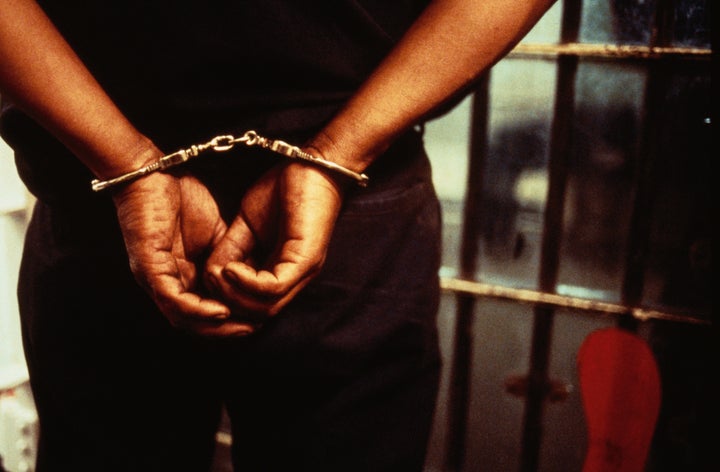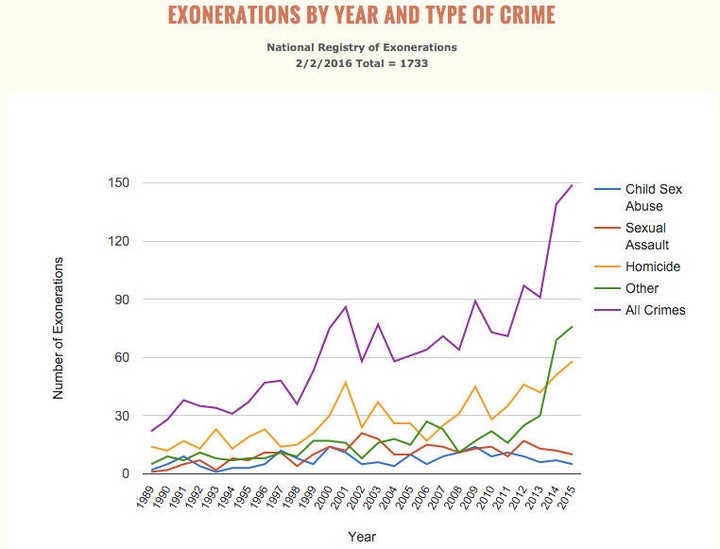
The Netfilx hit true-crime series “Making a Murderer” leaves many people wondering: Just how common is the story of a wrongful conviction in America’s criminal justice system? Too common, according a new report that tracks exonerations.
Researchers found that 149 people were cleared in 2015 for crimes they didn't commit -- more than any other year in history, according to a report published Wednesday by the National Registry of Exonerations, a project of the University of Michigan Law School. By comparison, 139 people were exonerated in 2014. The number has risen most years since 2005, when 61 people were cleared of crimes they didn't commit.
“Historically, this is a very large number for a type of event that we’d like to think almost never happens or just doesn’t happen,” Samuel Gross, a University of Michigan law professor who helped write the report, told The Huffington Post.
The men and women who were cleared last year had, on average, served 14.5 years in prison. Some had been on death row. Others were younger than 18 when they were convicted or had intellectual disabilities. All had been swept into a justice system that's supposed to be based on the presumption of innocence, but failed.
The high number of exonerations shows widespread problems with the system and likely “points to a much larger number of false convictions” that haven't been reversed, the report said.
“That there is an impetus at all to address the underlying problems that create false convictions is of course good news,” Gross said. “But the other side is equally important, probably more so: When you see this many exonerations, that means there is a steady underlying problem. We now know that this happens on a regular basis.”
Here are some patterns the organization found in 2015 exonerations:
Official Misconduct
About 40 percent of the 2015 exonerations involved official misconduct, a record. About 75 percent of the homicide exonerations involved misconduct.
The wrongful conviction of Debra Milke, detailed in the report, was among them. Authorities accused Milke of conspiring with two men who shot her son in the back of the head to keep him from her ex-husband and to cash in on an insurance policy. Milke’s conviction was built largely on the testimony of now-retired Phoenix police Detective Armando Saldate Jr., who said Milke offered him sex during questioning and confessed to the murder. The interrogation wasn't recorded, and Milke’s defense argued Saldate had a long history of misconduct that the state had concealed. In multiple other cases, the defense lawyers said, judges had tossed out confessions or indictments because Saldate had lied or violated defendants' rights.
The U.S. 9th Circuit Court of Appeals agreed with Milke’s attorneys and overturned her conviction. Milke had always maintained her innocence. She spent 26 years in prison -- 22 on death row -- before she was exonerated.

False Confessions
Almost 20 percent of exonerations in 2015 were for convictions based on false confessions -- a record. Those cases overwhelmingly were homicides involving defendants who were under 18, intellectually disabled, or both.
Bobby Johnson, of New Haven, Connecticut, was 16 years old with an IQ of 69 -- just below the threshold for intellectual disability -- without a parent or guardian present when he confessed to two detectives that he murdered 70-year-old Herbert Fields.
Johnson received a 38-year sentence in 2007. But in 2015, a new defense attorney argued that Johnson's confession was coerced by the detectives, who lied that they had evidence linking him to the murder that would subject him to the death penalty. The lawyer also argued police ignored evidence that the murder was linked to two other killings committed by others. Nine years after his conviction, Johnson was exonerated and set free.
In a separate analysis of hundreds of cases since 1989, false confessions were found to be a leading cause of wrongful convictions, according to the Innocence Project, a nonprofit dedicated to correcting wrongful convictions. Overall, about 31 percent of wrongful conviction cases included a false confession. For homicides, that number balloons to 63 percent.

Guilty Pleas
An innocent person pleading guilty to a crime they didn’t commit may seem unfathomable. But the National Registry of Exonerations said the number of false guilty pleas has been increasing for seven years, and has risen sharply in the past two years.
More than 40 percent of people exonerated in 2015 were convicted based on guilty pleas made by an innocent defendant, a record. The majority of these cases involved drugs. Some were homicide cases.
“Many people, including judges, take comfort in knowing that an overwhelming number of criminal cases are resolved by guilty plea rather than trial,” Judge Alex Kozinski, of the 9th Circuit Court of Appeals, wrote last year in a paper critiquing the criminal justice system. But Kozinski said this attitude fails to account for issues surrounding plea deals that include the trend of bringing multiple counts for a single crime, the “creativity” of prosecutors in “hatching up criminal cases where no crime exits” and the general “overcriminalization of virtually every aspect of American life.”
Plea bargains can be an efficient way to resolve cases without draining taxpayer resources. They aren’t always bad. But a 2013 Human Rights Watch study found the U.S. system often creates situations where a federal prosecutor will "strong-arm" a defendant into a plea deal. And the deep fear of a harsh sentence -- one “so excessively severe, they take your breath away,” in the words of Judge John Gleeson of the Eastern District of New York -- can lead a defendant to plead guilty in order to obtain a shorter prison term, even if they're accused wrongfully.
One example of plea deal complexities is the case of Shawn Whirl, who pleaded guilty to the first-degree murder of Chicago cab driver Billy Williams in 1991, according to the report.
Whirl’s defense argued he was being chased by an assailant the day he wound up in the back of Williams' cab. The same assailant later killed Williams in retaliation for rescuing Whirl, the lawyers said. Whirl confessed to the crime, but said it was because he was tortured by a Chicago cop. When prosecutors announced they would seek the death penalty, Whirl agreed to plead guilty to murder and armed robbery to save his life -- even though he said in court on the day he received a 60-year sentence that he was innocent.
It wasn't until 2012 that the Illinois Torture Inquiry and Relief Commission, formed to investigate claims of torture against Chicago police, found that Whirl had indeed been tortured by a subordinate of Jon Burge -- an ex-Chicago cop who led a police torture ring that used electrical shock, burnings and beatings on more than 100 black men.
Whirl was cleared of all charges on Oct. 13 and freed.

No Crime Was Actually Committed
In about half of the exonerations in 2015, no crime was actually ever committed by the people put behind bars -- a record, according to the report. Most of these cases involved drugs. Some included homicide or arson.
The report details the 1981 conviction of Raymond Mora, William Vasquez and Amaury Villalobo on six counts of murder for starting a fire in a Brooklyn, New York, building that killed a mother and her five children. The convictions were based on the building owner’s account that she saw the men leaving shortly before the fire, and a fire marshal's testimony that the blaze had multiple origin points and was started with accelerants -- signs of arson.
Each of the men’s wives gave alibi testimony that the men weren't near the building when the fire started. All three men were convicted and sentenced to 25 years to life.
Mora died in prison in 1989. Vasquez lost his eyesight due to untreated glaucoma, according to the report. In 2012, Vasquez and Villalobos were released on parole, and Villalobos sought the help of a legal clinic. Records from the case were reexamined and, using modern science, John Lentini, an arson expert, concluded that the original fire marshal’s interpretation of the evidence was mistaken, based on science that has since been disproven. This kind of expert testimony has likely resulted in "numerous" wrongful convictions, Lentini said.
Moreover, the building owner, just before she died, admitted lying about seeing the three men leaving the building at the time of the fire. She also hid an insurance settlement.
After this new evidence was presented, the convictions of all three men were vacated in December.

Flawed Forensic Evidence
Many of last year's exonerations involved flawed or invalid forensic evidence. According to the Innocence Project, improper forensic science is a leading cause of wrongful conviction.
Too often, the group says, forensic experts speculate when they testify, asserting conclusions that stretch the science. Further, some forensic techniques aren't backed by research, but are nevertheless presented to juries as fact. And there are honest mistakes. The FBI has admitted that from 1972 to 1999, almost every examiner in the bureau's elite forensics unit gave flawed testimony in nearly every trial in which they presented evidence.
Forensic fields like ballistics, bloodstain pattern identification and footprint and tire print analysis, have been “long accepted by the courts as largely infallible,” Kozinski said in his paper, arguing that the techniques should be viewed with skepticism.
Faulty Eyewitness Identification
False identifications of innocent people happened in several cases the exoneration registry report outlined.
The Innocence Project says eyewitness misidentification of a suspect plays a role in more than 70 percent of convictions that are later overturned through DNA evidence. Hundreds of studies have shown that eyewitness identification is frequently inaccurate and that human memories are not reliable, especially with traditional identification procedures. While simple reforms have been proposed, only about 14 U.S. states have implemented them, according to Innocence Project.
Kozinski called for states to adopt rigorous procedures for witness identification.
How Many More Wrongful Convictions?

There’s no clear data on how many innocent people have been wrongfully convicted. The Innocence Project, citing multiple studies, estimates from 2 percent to 5 percent of prisoners are actually innocent. The U.S., which leads the world in incarceration of its citizens, has approximately 2 million people behind bars. That means a wrongful conviction rate of 1 percent would translate to 20,000 people punished for crimes they didn't commit. On death row, 1 in 25 are likely innocent, according to a recent study.
“Because these things happen regularly, we should be more open-minded about reconsidering the guilt of convicted defendants when substantial new evidence emerges after conviction,” Gross said. “The impulse to say: ‘It’s over, I don’t want to think about it anymore’ is very strong. However, there are cracks in that position."
